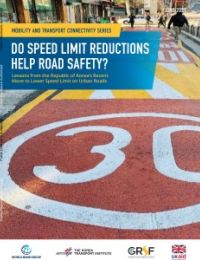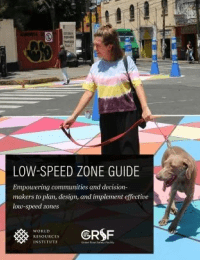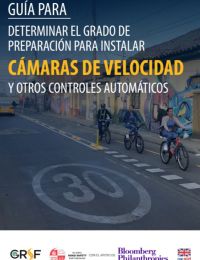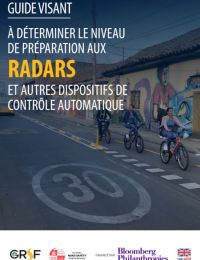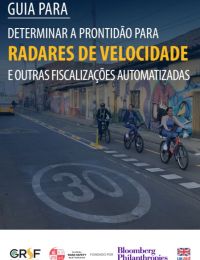Publications
11-19 of 19
- Evaluate the effectiveness of the reduced speed limits in terms of crash reduction through a before-after study.
- Examine if the speed limit change had different effects across different crash types, user types, and crash severities.
- Evaluate the impact of speed limit change on transit speed through a before-after assessment.
- Develop appropriate and actionable recommendations for departments of transportation in developing countries.
-
-
Traffic crashes are a leading cause of death and serious injury worldwide; most notably, they are the leading cause of death and serious injury among young people aged 5–29. Higher motor vehicle speeds increase the likelihood and severity of crashes.
-
Low-speed zones have emerged as one of the most promising strategies for speed management. They can be appropriate in many different contexts and at various scales, as exemplified by case studies of successful projects around the world.
-
Low-speed zones in cities need to be well-planned, well-designed, and well-built, to maximize safety and other benefits.
-
Physical traffic-calming measures and target speeds of 30 kilometers/hour (km/h) or lower have the greatest proven safety benefits.
-
Key considerations for implementation include stakeholder engagement, site selection (including risk: pedestrian/vulnerable road user presence), enforcement, evaluation, and the adaptation of basic principles for low-speed zone design to the local context.
- Xác định ngắn gọn giá trị thực tế mạnh mẽ của AE trong việc cứu sống và giảm thương tích.
- Xác định các vấn đề và tiêu chí cần xem xét trước khi bắt đầu thực thi tự động. Xác định các bước cần thực hiện để đạt được sự sẵn sàng cho việc thực thi tự động. Xác định các vấn đề để cải thiện các hệ thống thực thi tự động hiện có.
- Cung cấp danh sách kiểm tra để đảm bảo cân nhắc đầy đủ các vấn đề để đánh giá mức độ sẵn sàng triển khai hệ thống AE hoặc cải thiện hệ thống hiện có.
- Identificar brevemente el poderoso valor práctico de la AE para salvar vidas y reducir las lesiones.
- Identificar los problemas y criterios que se deben considerar antes de comenzar la aplicación automática de la ley. Identificar los pasos que se deben tomar para lograr la preparación para la aplicación automática de la ley. Identificar los problemas para mejorar los sistemas de aplicación automática de la ley existentes.
- Proporcionar una lista de verificación para garantizar que se tenga en cuenta adecuadamente los problemas para evaluar la preparación para implementar un sistema de AE o mejorar un sistema existente.
- Identifier brièvement la valeur pratique considérable du CA pour sauver des vies et réduire les blessures.
- Identifier les problèmes et les critères à prendre en compte avant de commencer le contrôle automatisé. Identifier les mesures à prendre pour se préparer au contrôle automatisé. Identifier les problèmes pour améliorer les systèmes de contrôle automatisé existants.
- Fournir une liste de contrôle pour garantir que les problèmes sont pris en compte de manière adéquate pour évaluer l'état de préparation à la mise en œuvre d'un système CA ou à l'amélioration d'un système existant.
- Identificar brevemente o poderoso valor prático da AE em salvar vidas e reduzir ferimentos.
- Identificar problemas e critérios a serem considerados antes de iniciar a fiscalização automatizada. Identificar etapas a serem tomadas para atingir a prontidão para a fiscalização automatizada. Identificar problemas para melhorar os sistemas de fiscalização automatizados existentes.
- Fornecer uma lista de verificação para garantir que a consideração adequada seja dada aos problemas para avaliar a prontidão para implementar um sistema AE ou melhorar um sistema existente.
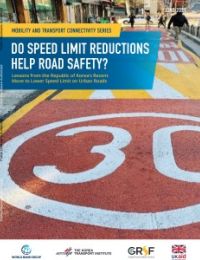
Significant research has been undertaken on how changes in speed limit—for example, the introduction of 30 kilometers per hour, or kph (20 miles per hour, or mph) speed limits—impact safety both when combined with, and without "traffic-calming" engineering treatments such as speed humps or raised platforms. However, most of the studies have been conducted in Australia or countries in Western Europe, with almost no recorded studies from Asia, Africa, the Americas, and Eastern Europe. Though it may be reasonable, a well-developed infrastructural environment such as that found in Korea would expect similar results as that of the western countries, a study originating in Asia could have a strong demonstration effect and prove very convincing for many Asian countries.
With this in mind, the main aim of this study is to present the findings from Korea’s reduced speed limits on safety performance and to support the establishment of suitable speed-management strategies based on a quantitative data-driven approach. The scope of the project was as follows:
To start, this report first provides a brief literature review on the concept of Safe System speed limits, and the effect of speed limit reductions as part of speed management in several countries, followed by a brief description of the evaluation methods for the before-after assessment. This is followed by a summary of the findings, a set of recommendations, limitations of this study, and finally, a capsule of future research that could be undertaken to either extend or follow up on the study.

Chi phí thực sự của việc chạy quá tốc độ đối với con người và môi trường là bao nhiêu? 6 biểu đồ sau đây sẽ cho biết câu chuyện
Tác động của tốc độ đối với sự an toàn của người tham gia giao thông, tình trạng tắc nghẽn, ô nhiễm và tổng chi phí đi lại trên đường bộ thường bị hiểu sai: thường dựa trên những giả định sai lầm, với những tác động được coi là hiển nhiên, không xem xét nhiều tác động, nhiều bên liên quan chuyển chi phí ra bên ngoài và đánh giá thấp tác động (đặc biệt là chi phí kinh tế khi chạy với tốc độ cao). Mục đích của bản ghi chú ngắn này là cung cấp thông tin về những mối quan hệ này có liên quan đến các chính sách, thiết kế và hoạt động cơ bản của giao thông đường bộ. Bằng chứng rõ ràng cho thấy tầm quan trọng của việc quản lý tốc độ di chuyển để đảm bảo an toàn giao thông, hiệu quả, cải thiện sự hòa nhập và khí nhà kính (GHG) cùng các khí thải khác. Do đó, quản lý tốc độ là đòn bẩy chính sách mạnh mẽ đối với nhiều vấn đề cần được giải quyết để có khả năng di chuyển bền vững.
Giảm tốc độ di chuyển là một cơ hội lớn nhưng chưa được đánh giá đúng mức để cải thiện sự an toàn, tác động của biến đổi khí hậu đối với giao thông, sức khỏe, sự hòa nhập, nền kinh tế và trong một số trường hợp là tình trạng tắc nghẽn. Quản lý tốc độ có thể đạt được thông qua một loạt các biện pháp can thiệp bao gồm cơ sở hạ tầng đường bộ và công nghệ xe cộ, cũng như thực thi và thúc đẩy.
Sáu biểu đồ được trình bày trong ghi chú này kể một câu chuyện mạnh mẽ, trong phạm vi các lợi ích của việc quản lý tốc độ.

¿Cuál es el costo real del exceso de velocidad para las personas y el medio ambiente? Estos 6 gráficos lo cuentan.
Los impactos de la velocidad en la seguridad de los usuarios de la vía, en la congestión, en la contaminación y en los costos totales de los viajes por carretera son ampliamente malinterpretados: a menudo se basan en suposiciones erróneas, con efectos que se toman como evidentes, no se consideran múltiples impactos, muchas partes interesadas externalizan los costos y se subestiman los impactos (especialmente los costos económicos de las velocidades más altas). El propósito de esta breve nota es proporcionar información sobre estas relaciones relevantes para las políticas fundamentales del transporte por carretera, el diseño y la operación. La evidencia bien establecida muestra la importancia de gestionar las velocidades de viaje para la seguridad vial, la eficiencia, la mejora de la inclusión y las emisiones de gases de efecto invernadero (GEI) y otras. Por lo tanto, la gestión de la velocidad es una fuerte palanca de política para la amplitud de cuestiones que deben abordarse para la movilidad sostenible.
La reducción de la velocidad de viaje representa una oportunidad importante, aunque subestimada, para mejorar la seguridad, los impactos del cambio climático de los viajes, la salud, la inclusión, la economía y, en algunas circunstancias, la congestión. La gestión de la velocidad se puede lograr mediante una serie de intervenciones, que incluyen la infraestructura vial y la tecnología de los vehículos, así como la aplicación de la ley y la promoción.
Los seis gráficos presentados en esta nota cuentan una historia poderosa sobre la gama de beneficios de la gestión de la velocidad.
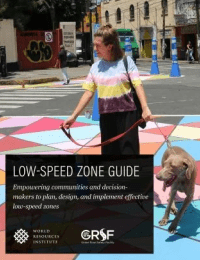
Every year approximately 1.35 million people lose their lives due to road traffic crashes. In many road crashes, speed plays a key role. As a result, managing speed has taken on great importance in cities around the world.
An effective method for reducing speed and improving road safety, especially in high-risk areas, has been to establish low-speed zones. This Low-Speed Zone Guide presents strategies for planning, designing, building, and evaluating low-speed zones. The guide intends to equip communities and decision-makers with the tools to implement low-speed zones that will suit their specific context.
Highlights:

Hướng dẫn này được biên soạn để hỗ trợ một khu vực pháp lý xác định mức độ sẵn sàng chuyển sang thực thi tự động (AE). Camera tốc độ thực thi giới hạn tốc độ là một ứng dụng phổ biến của AE và có nhiều yếu tố pháp lý và hoạt động có hệ thống phải được áp dụng trước khi AE có thể có hiệu quả. Ví dụ, hình ảnh chính xác của một phương tiện chạy quá tốc độ, khi không có hệ thống cấp phép lái xe và đăng ký xe mạnh mẽ, thì giá trị an toàn đường bộ không cao. Điều quan trọng là, thực thi tốc độ tự động nên được coi là một phần của phương pháp quản lý tốc độ toàn diện bao gồm cả cơ sở hạ tầng đường bộ và cảnh sát ven đường. Quản lý tốc độ là một yếu tố cơ bản của Hệ thống an toàn.
Mục đích của tài liệu này:
Các hành vi bất hợp pháp khác, bao gồm không tuân thủ tín hiệu đèn đỏ, sử dụng điện thoại di động hoặc điện thoại di động, đi sai làn đường và không sử dụng biện pháp hạn chế cũng có thể được phát hiện bằng cách sử dụng phương pháp thực thi tự động. Tuy nhiên, tài liệu này áp dụng cụ thể cho việc thực thi tốc độ tự động, vì quản lý tốc độ đòi hỏi sự chú ý đáng kể trên toàn thế giới và đóng vai trò quan trọng trong việc giảm tử vong và thương tích do tai nạn giao thông đường bộ.
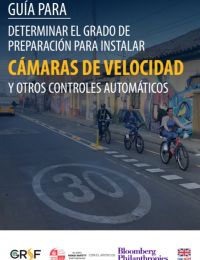
Esta guía se ha preparado para ayudar a una jurisdicción a determinar el nivel de preparación para pasar a la aplicación automática de la ley (AE). Las cámaras de control de velocidad que hacen cumplir los límites de velocidad son una aplicación común de la AE y hay muchos elementos legales y operativos sistémicos que deben estar en su lugar antes de que la AE pueda ser efectiva. Por ejemplo, una imagen precisa de un vehículo que va a exceso de velocidad, en ausencia de sistemas sólidos de licencias de conducir y registro de vehículos, tiene poco valor para la seguridad vial. Es importante destacar que la aplicación automática de la ley de velocidad debe considerarse como una parte de un enfoque integral de gestión de la velocidad que también incluye la infraestructura vial y la vigilancia en la carretera. La gestión de la velocidad es un elemento fundamental del Sistema Seguro.
Objetivos de este documento:
También se pueden detectar otras conductas ilegales, como desobedecer una señal de luz roja, usar el teléfono móvil o celular, usar un carril incorrecto y no usar el dispositivo de retención mediante un enfoque de control automatizado. Sin embargo, este documento se aplica específicamente al control automatizado de la velocidad, porque la gestión de la velocidad requiere una atención significativa en todo el mundo y desempeña un papel fundamental en la reducción de las muertes y lesiones por accidentes de tránsito.

Ce guide a été préparé pour aider une juridiction à déterminer le niveau de préparation à la mise en œuvre d'un contrôle automatisé (CA). Les radars de contrôle des limites de vitesse sont une application courante du CA et de nombreux éléments juridiques et opérationnels systémiques doivent être mis en place avant que le CA puisse être efficace. Par exemple, une image précise d'un véhicule roulant à grande vitesse, en l'absence de systèmes robustes de délivrance de permis de conduire et d'immatriculation des véhicules, n'a que peu de valeur pour la sécurité routière. Il est important de noter que le contrôle automatisé de la vitesse doit être considéré comme une partie d'une approche globale de gestion de la vitesse qui comprend également l'infrastructure routière et la police routière. La gestion de la vitesse est un élément fondamental du système sûr.
Objectifs de ce document :
D’autres comportements illégaux, comme le non-respect d’un feu rouge, l’utilisation d’un téléphone portable, le franchissement incorrect de la voie et l’utilisation d’un dispositif de retenue, peuvent également être détectés à l’aide d’une approche automatisée de contrôle de la vitesse. Cependant, ce document s’applique spécifiquement au contrôle automatisé de la vitesse, car la gestion de la vitesse requiert une attention particulière dans le monde entier et joue un rôle essentiel dans la réduction des décès et des blessures sur les routes.
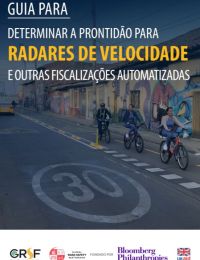
Este guia foi preparado para auxiliar uma jurisdição a determinar o nível de prontidão para mudar para a fiscalização automatizada (AE). Câmeras de velocidade que fiscalizam limites de velocidade são uma aplicação comum de AE e há muitos elementos legais e operacionais sistêmicos que devem estar em vigor antes que a AE possa ser eficaz. Por exemplo, uma imagem precisa de um veículo em alta velocidade, na ausência de sistemas robustos de licenciamento de motoristas e registro de veículos, tem pouco valor para a segurança nas estradas. É importante ressaltar que a fiscalização automatizada de velocidade deve ser considerada como parte de uma abordagem abrangente de gerenciamento de velocidade que inclua infraestrutura rodoviária e policiamento de beira de estrada também. A gestão da velocidade é um elemento fundamental do Sistema Seguro.
Objetivos deste documento:
Outros comportamentos ilegais, incluindo desobediência a um sinal vermelho, uso de telefone celular ou celular, uso incorreto de faixa e uso sem restrição também podem ser detectados usando uma abordagem de fiscalização automatizada. No entanto, este documento se aplica especificamente à fiscalização automatizada de velocidade, porque o gerenciamento de velocidade requer atenção significativa em todo o mundo e desempenha um papel crítico na redução de mortes e ferimentos no trânsito.

Based on 2018 findings of the World Health Organization (WHO), the number of deaths due to road crashes is 1.35 million deaths per year. While this number is quite high and increasing every year, the rate of road crash deaths per 100,000 of population has remained constant, at around 18 deaths, over the years. This rate of deaths is however not distributed proportionately amongst the different regions and countries. The high-income countries have recorded lowest average rate at 8.3 per 100,000. In contrast to this number, low-income countries have the highest annual road traffic fatality rates averaging at 27.5 deaths per 100,000– more than three times the average for high-income countries.
ROAD CRASH AND IMPACT
Most of the deaths and injuries from road crashes are of the working age population, which negatively impacts both the economy and the demography of the region. Road traffic injuries are currently the 8th leading cause for death for all age groups, and further compounding the demographic impact is the fact that road crashes are the leading cause of death for children and young adults, between the ages of 5 and 29 years.
Road traffic crashes have a high economic impact, costing 3 percent of a country’s GDP on average. They also cause a significant impact on the individuals as well as their families. Injuries arising due to road crashes can lead to trauma for the individual and loss in productivity. Along with costs of treatment, economic challenges may further be increased due to temporary or permanent loss of income as well. Along with the victim, road crashes take an emotional toll on the immediate family members and caregivers during the treatment process or any deaths and add to the economic burden as they may need to take time off work or school to care for the injured.
The distribution of road users varies within different regions and income groups of countries. This impacts the variations in death rates amongst the users. The low- and middle-income countries have a significantly high proportion of pedestrians, cyclists and two- or three-wheeler motorized vehicles. Overall, the global road traffic deaths for pedestrians and cyclists is at 26% and another 28% for two- and three-wheeler motorcyclists, totaling nearly 54% of vulnerable road users. This proportion varies in comparison between the economic group of countries, with a high percentage of road crash victims being car occupants.
Globally, a significant percentage of road crash victims being car occupants is also an indicator of insufficient infrastructure for controlling traffic speeds and volumes. Furthermore, when people use private cars more for their daily activities, it results in a higher level of total vehicle-kilometers traveled (VKT). Choice of using personal vehicle over using non-motorized transport or public mass transport may be attributed to the car-centric planning and design of road infrastructure. Many countries lack adequate protected infrastructure for pedestrians and cyclists. This discourages users to walk or bicycle to their destinations.
Mode-choice plays a critical role in road safety. Public mass transit systems not only provide faster and safer transportation mode choices, they also help reduce dependency on privately owned vehicles on the road. Public mass transit services typically follow designated routes as well, thereby minimizing interferences between different types of road users. While many countries still have to develop mass transit infrastructure such as metro rails, public bus system is quite prevalent, with bus rapid transit (BRT) and bus only lane infrastructures being developed. Absence of proper first and last mile connectivity to the transit stations poses security threats for road users and discourages them from using public transport.
SAFE SYSTEM APPROACH
The Safe System approach derives from the Swedish Vision Zero and Dutch Sustainable Safety strategies that have a long-term goal for a road traffic system to be eventually free from fatalities and serious injuries. It represents a shift away from traditional approach of preventing collisions to a more forgiving approach of preventing fatalities and mitigating serious injuries in road crashes. The traditional approach emphasizes the responsibility of road users to avoid crashes rather than the responsibility of system designers to provide a safe mobility system.
The Safe System approach takes into account that humans are vulnerable and fallible, and errors are to be expected. It aims at ensuring these mistakes do not lead to a crash, and if a crash does occur, it is sufficiently controlled to not cause a death or a life-changing injury. Thereby with a “zero-harm goal”, it places a strong emphasis on road builder/operator and vehicle manufacturer accountability for road safety performance.
The Safe System approach emphasizes shared responsibility. Government agencies at different levels and a range of multisectoral agencies and stakeholders – including policy makers, road engineers, planners, vehicle manufacturers, enforcement officers, emergency medical agencies, road safety educators etc. – are accountable for the system’s safety and all road users – drivers, cyclists, and pedestrians are responsible for complying with the system rules.

